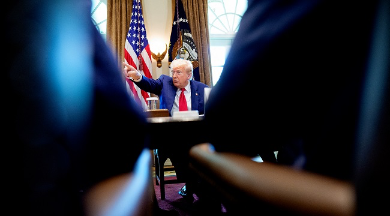
The U.S. economy unexpectedly contracted in the first quarter of 2025, as businesses and consumers rushed to import foreign goods ahead of sweeping new tariffs introduced by President Donald Trump. Despite the downturn, Trump deflected blame, attributing the slowdown to his predecessor, former President Joe Biden.
Gross domestic product (GDP) fell at an annualized rate of 0.3% in the first three months of the year, a sharp reversal from 2.4% growth in the final quarter of 2024, according to preliminary data from the U.S. Commerce Department released Wednesday. It marked the first quarterly contraction since 2022 and fell well short of economists’ expectations for 0.4% growth, as reported by Briefing.com.
The Commerce Department cited a surge in imports—fueled by efforts to beat the tariffs—as a key driver of the contraction, compounded by declines in both consumer and government spending.
All three major Wall Street indices dipped following the GDP report, though they later recovered to close mixed. Oil prices, meanwhile, continued to slide.
Speaking at a cabinet meeting in Washington, Trump framed the downturn as a “legacy of Bidenomics.”
“That’s Biden, not Trump,” he said, while touting a 22% jump in gross domestic investment, which he called a sign of underlying strength.
During Biden’s presidency, annual economic growth remained above 2%, peaking at 2.8% in 2024. But Trump officials insist the current contraction reflects inherited structural weaknesses.
“It’s no surprise the leftovers of Biden’s economic disaster have been a drag on growth,” said White House Press Secretary Karoline Leavitt. “But the underlying numbers show the strong momentum President Trump is delivering.”
The report comes on Trump’s 101st day back in office and follows heightened market volatility driven by the administration’s aggressive tariff strategy. The new trade regime—introduced in January—imposes blanket 10% tariffs on most imports, with additional levies pushing Chinese goods to duty rates of 145% or more in key sectors.
The sharp escalation prompted an initial selloff in early April and sparked fears of a global trade war. In response, the Trump administration introduced a 90-day pause on the higher tariffs for dozens of countries to allow trade talks to proceed. China, however, was not among the countries granted relief and has responded with retaliatory tariffs on American goods.
Trump remained defiant on Wednesday, saying China was being “hammered” by U.S. tariffs, though he expressed hope for a deal. Referring to China as “the leading candidate for the chief ripper-offer of America,” he suggested that Americans might have to adjust to higher prices and fewer imported products.
“Maybe the children will have two dolls instead of 30,” he said. “And maybe the two dolls will cost a couple bucks more than they would normally.”
Democrats seized on the GDP figures as a warning sign. “This decline is a blaring alarm that Trump’s MAGA economic experiment is damaging the economy,” said Senate Majority Leader Chuck Schumer.
Analysts at Wells Fargo offered a more tempered view, saying the economy is now at greater risk of recession but cautioning against overreaction.
“This 0.3% contraction is not the start of a recession,” they wrote in a client note. “It reflects the abrupt policy shift that caused the largest drag from net exports in more than 50 years.”